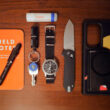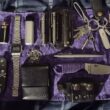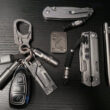In this installment of Carry Smarter, I’m going to take you through the basics of choosing and carrying a modern flashlight, and how and why a good one — even without a ridiculous amount of lumens and features — is worth a spot in your EDC.
“Why should I carry a flashlight when my phone has one?”
As a flashaholic, this is by far the most common question we get from people who see the flashlights in our EDCs. It’s also a perfectly valid one. Why should we carry an extra piece of equipment that would just weigh down our pockets, when the phone we carry with us all the time can perform all the lighting tasks we need in normal situations? My favorite response to that question has always been: “You would bring an umbrella without a thought for a 50% chance of rain, so why wouldn’t you carry a light for a 100% chance of darkness every night?”
The Right Tool for the Job
While a mobile phone flashlight can fulfill basic lighting tasks, the goal of carrying a dedicated flashlight is to be the best tool for the job. As an example: you could certainly open boxes and prep food with the same dinner knife, but wouldn’t a box cutter and a chef’s knife be better for those tasks? A dedicated tool also means a more focused and specific set of features. In the case of flashlights, this means more power, sturdier construction, and the fact that on some outputs a light’s runtime is measured in days. It comes in handy in emergency situations where your phone is the quickest to run out of power and darkness is one of the first challenges you’d need to overcome.

Shedding Light on Your Needs
With dozens of brands and hundreds of options and features in the market, it’s easy to get overwhelmed by the sheer amount of choice in choosing a first light. Even knowing what I do about lights it’s still hard for me to make a purchase because of how specific some of my needs are. The important thing is to think about how a light would benefit your carry and the usual situations you’re in where an extra bit of light would be helpful. Here are some things to consider when choosing a light:
- Convenience: A light is useless if it’s a hassle to carry every day. Do you prefer a light that is small enough to go on your keychain, or something larger that would have a bigger battery for more power and runtime? Is the light something you’ll carry daily in your pants, or something handy for emergencies in your bag or glove box? A light should be there the moment you need it but quietly stay out of your way when you don’t.
- Ease of use: You may be like Adam Savage who prefers his light modes to be as simple as possible, or someone who wants as many modes and functions as possible at their disposal. What’s important is that your light functions as easily as possible to you. You’ll end up leaving your light at home if it fails to perform just the way you like it exactly when you need it.
- Runtime: This is, in my opinion, the best reason to carry a light. Yes, at the end of the day, your phone’s light might get the job done. Unfortunately, the end of the day is also the usual quitting time for your phone’s battery unless you have access to an outlet or a portable battery pack. For the price of said pack and a fraction of the space, you could get a light that will see you through the night long after your phone has died.
Ordinary Cells, Extraordinary Value
So you’ve thought about how a light would fit in your carry and are ready to take on the daunting task in choosing your first one, but that doesn’t decrease the number of choices out there. My recommendation is to start with something small and inexpensive, and work your way up to lights with easily-accessible primary cells. Here are my picks for solid lights to get you started.
Button Cell

Nitecore Tube Keychain Light
At one point or another, most flashaholics started with these lights. They’re inexpensive, durable due to the plastic design, plenty bright for everyday tasks, and invisible on a keychain. The Nitecore Tube has made waves since its release as it takes those qualities and levels them up in every way. For little investment you get durable Polycarbonate construction, 45 variable lumens at the push of a button, and extremely convenient micro USB charging. Whether or not you move on to bigger lights, you can’t go wrong with this on your keychain.
Single AAA Battery

Fenix LD02
AAA lights are a great balance of form and function. They’re compact enough to easily carry on a keychain or disappear in your pocket, and extremely convenient to power due to AAA cells being available in every convenience store in the world. The Fenix LD02 is small in size, but big on features. Its simple rear clicky activation makes cycling through its three brightness levels a breeze. It’s 8-lumen low setting can keep going for 15 hours, while it’s 100-lumen high is not a brightness you’d believe possible from such a tiny package. An AAA flashlight should be the first stop for every EDC, and the LD02 is a solid pick from one of the most reliable brands on the market.
Single AA Battery
ThruNite T10
The AA cell is just as common as its AAA little brother, but has about three times the capacity for a much longer runtime. The ThruNite T10 makes amazing use of the battery, fueling its 0.2-lumen firefly low setting for an unbelievable 147 hours — that’s almost a full week of continuous light! It also has a simple rear clicky activation for fuss-free operation. If you can spare the room for its larger body (which comes in a variety of materials to fit your style and preference), the T10 will light up your evenings for a very, very long time.
A Bright Future Ahead
Now that you’ve given thought to how having a dedicated light will improve your carry and maybe picked out your first one, what now? In the next installment of Carry Smarter, I take a look at some unique lights and their uncommon features that may prove useful companions to your daily carry.
Did I miss out on reasons why a light is useful for your EDC? What would you recommend as a practical and useful light to invest in? Sound off in the comments below!










